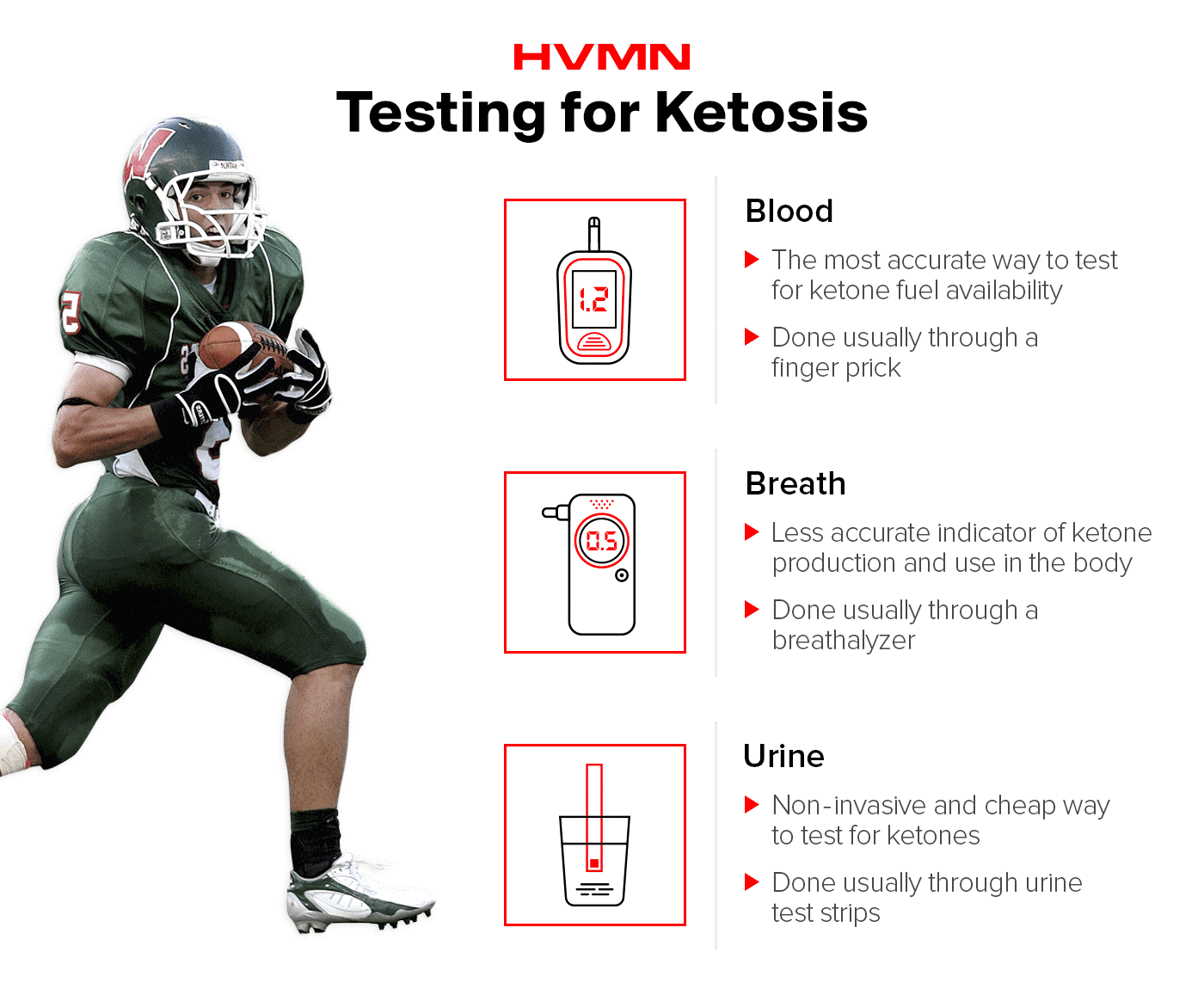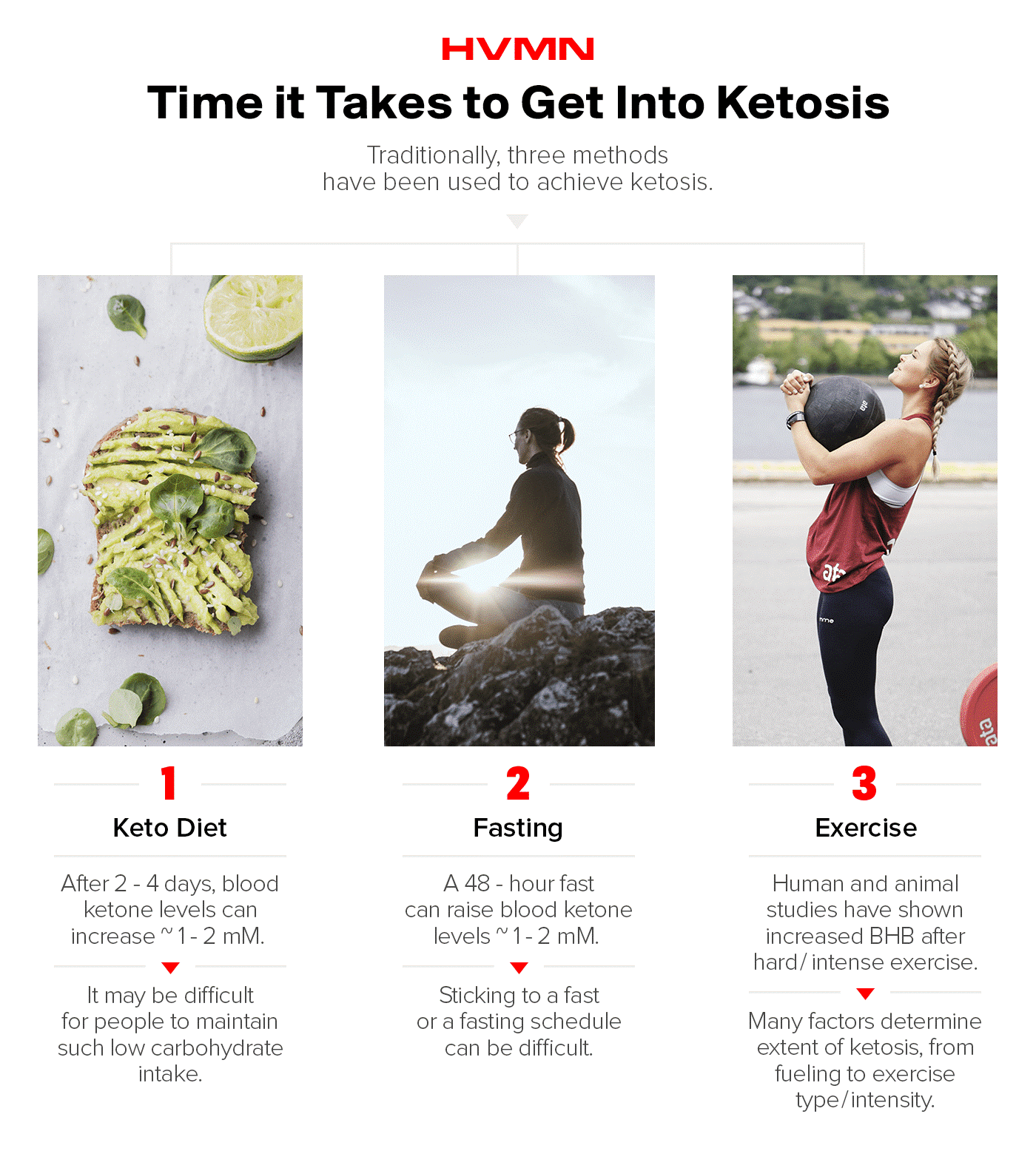How Long Does It Take to Enter Ketosis
Originally published on HVMN by Nate Martins
Weight loss benefits ushered the keto diet into the spotlight. That's how most people have likely heard about ketones, a fuel source created naturally by the body when burning fat. But more and more research points to diverse applications of ketones in the blood outside of just fat loss, from improved endurance performance to the treatment of medical conditions like epilepsy.
Ketosis is the state of raised ketone bodies in the blood, typically beginning at 0.5 mM. But how does one get ketones in the blood?
It happens two ways (you can read our in-depth analysis here).
Endogenous ketones are produced naturally by the body while fasting or on a strict low-carb, high-fat diet. The body becomes ketogenic, which means it's producing ketones. Thus, ketones are in the blood, designating a state of ketosis.
Exogenous ketones are introduced to the body from an external source, like HVMN Ketone, MCT oils or ketone salts. The body isn't ketogenic here, but is still in a state of ketosis because ketones are in the blood.
Naturally, it can take days to achieve ketosis through fasting or dieting. With ketone supplements like HVMN Ketone, it can take minutes.
But everyone is different. Getting into ketosis varies from person-to-person, and even two people using similar methods can have different results.
How to Know You're in Ketosis
The best way is to test. There are a few different ways to test for beta-hydroxybutyrate (BHB)–the predominant ketone body present in the body.
Blood testing, with a blood ketone meter, is the most accurate. A range of 0.5 - 3.0 mM of BHB in the blood represents nutritional ketosis,1 and can be achieved both endogenously or exogenously. But it requires a finger-pricking, which can be off-putting to some. Plus, ketone testing strips can get expensive.
Ketones can also be measured via breathalyzer or urine ketone sticks. While these methods are useful for estimating blood ketone levels, they're less accurate than blood measurements and less reliable when the body contains higher levels of BHB (or if you've been on a ketogenic diet for a long time).2,3,4

Those new to keto should be testing to see if their bodies are in ketosis, regardless of method. Testing, in general, is the most objective way to know if you're in ketosis. There can be some subjective benefits of ketosis: appetite suppression, fat loss, low blood sugar, improvement in mental cognition and focus. But before recognizing these subjective benefits, it's important to track and measure the level of ketones in the blood to ensure ketosis on a physical level.
How Long Does It Take to Get Into Ketosis?
It depends on the method you're using.
Ketogenic Diet
Western diets are high in carbohydrates, leading to high blood sugar levels, whereas the ketogenic diet enforces a small amount of carbs to be consumed.
After 2 - 4 days of low-carbohydrate, high-fat ketogenic dieting, ketone levels in the blood can increase to ~1 - 2 mM, achieving ketosis.5
Difficulties reaching these levels might lead some dieters to reduce carbs even further, increasing fat intake and lowering protein intake. While one person may need to drop carbs down to 20 grams per day, another may see results on 100 grams of carbs (especially if they're highly active).
Remember how important it is to measure ketone blood levels accurately? Same goes for food tracking. A food tracking app, like MyFitnessPal, provides insight into macronutrient intake and thus the ability to tweak the diet to achieve ketosis. Tracking diet (inputs) and measuring ketones levels (outputs) delivers the best shot at optimizing the keto diet plan.
Fasting
Intermittent fasting is a simple and effective way to lose weight, decrease body fat and enhance overall health.6 The body increasingly relies on fat stores for energy, and some of that fat is turned into ketones, resulting in ketone levels increasing in the blood.
There are several ways to approach the "intermittent" part of food restriction. One of the most common is limiting the window in which food is consumed to about eight hours a day. Another is fasting for a full 24 hours once a week, or once a month. Fasting beyond three days can be stressful on the body and should be done with medical advice and supervision.
Fasting for just 12 - 16 hours can achieve ketosis, albeit at lower levels at about ~.05mM.7 But a 48-hour fast can boost ketone levels in the blood by 20x, between 1 - 2mM.
Exercise
Human and animal studies have shown exercise increases BHB.8,9,10
The level of post-exercise ketosis, however, is influenced by several factors, including: exercise intensity, duration of the exercise, training experience level (athletes vs. non-athletes) and diet. But diet might be the most important of these factors.
Diet influences levels of glycogen stores, and exercise triggers depletion of glycogen stores–this depletion is critical for ketosis, and has an impact on blood ketone levels following exercise. If one exercises and doesn't eat carbohydrates after, this can also speed up the process of natural ketone production.
A low-carb diet increases post-exercise ketosis, whereas a high carbohydrate intake inhibits it, regardless of the other factors.10

Can I Get Into Deep Ketosis Faster?
A ketogenic diet, intermittent fasting and exercise can all work symbiotically encourage a state of ketosis. Even together, all these endogenous methods take time.
Enter exogenous ketones.
Exogenous ketone supplements provide a way to fast-track deep ketosis. There are two types of exogenous ketone supplements currently available, with one outlier.
Medium-chain triglycerides (MCT) oil is the outlier. It doesn't actually contain ketones, but instead, a fat easily converted into BHB. After taking MCT, blood ketone levels rise slowly over several hours.
MCT oil is extracted primarily from coconut oil, and derives unique benefits from its shorter fatty acid chain length. Most dietary fat contains 12 carbons in the fatty acid chain, while MCTs are only 6 - 12 carbon chains in length. Shorter chain length allows for easier absorption and rapid conversion to energy in the liver, specifically caprylic (C8) and capric (C10).
Exogenous ketones include salts and esters. Both can quickly raise blood concentrations of BHB within minutes and quickly induce a deep state of ketosis without dieting or fasting.
Studies have shown ketone esters, like HVMN Ketone, more potently raise blood ketones when compared to salts.
That was nearly three-times the level attained by a ketone salt drink.4
Other studies have reported D-BHB levels (the ketone body present in HVMN Ketone) up to 6.0 mM following ingestion of D-BHB ketone ester drinks.11,12
Keto-Adaptation Doesn't Happen Overnight
Keto-adaption is a complex set of metabolic processes in which the body shifts from using primarily glucose for energy to using largely ketones and fat for energy. Achieving ketosisdoesn't mean the body is maximizing the use of these ketones; it takes longer than a few days for the body to get used to burning fat and ketones as its predominant fuels.
Human research evaluating the long-term effects of a low-carb diet is very limited. Most studies on low-carb diets rarely run more than two weeks, so finding a definitive answer for how long it takes to keto-adapt is unclear.
But analyzing a few different adaptations, which are triggered by the keto diet, can provide a clearer picture of the time it takes to keto-adapt.

Higher Fat Utilization
The potential for fat burning during exercise can be increased massively while on the ketogenic diet.
Recently, a study in keto-adapted elite runners demonstrated keto athletes burned double the amount of fat at the relatively high exercise intensity of 70% (compared to athletes on a normal diet).
Keto athletes consistently followed a low carb, high-fat ketogenic diet for six months. They ate 82 grams of carbs a day, compared to a high-carb group of runners who consumed 684 gram of carbs per day.13 Increases in fat burning have also been seen after far shorter time intervals on the ketogenic diet.14
One should allow weeks or months of adoption for prime athletic performance on the ketogenic diet.
Glycogen Conservation
Prevailing thought says muscle glycogen is lower than normal when carbohydrate intake is restricted. But keto-adaption changes this.
A major study in keto-adapted elite runners demonstrated that muscle glycogen was the same as athletes who ate ample carbs. Over time, the body adapts to be able to make more carbohydrates–by a process called gluconeogenesis–and this keeps muscle glycogen levels close to normal even without dietary carbohydrates.
Ketones are Brainfood
The brain runs on glucose or ketones–not fat.
During ketosis, other tissues in the body adapt to use fatty acids for fuel. This process spares ketones for the brain, while also saving protein breakdown to make glucose. Muscle specifically undergoes a major shift.
Early in the keto diet, muscle cells use both ketones and fatty acids for energy. But once fully keto-adapted, muscle turns to fatty acid as primary fuel. This adaption in fuel flow can take weeks or months.15
More Mitochondria, More Energy
Though human studies are lacking, evidence from animal studies indicates the keto diet can increase creation of new mitochondria (called mitochondrial biogenesis).16,17,18
Why are more mitochondria important? They're the cell's workhorses.
On a cellular level, mitochondria are where fuel converts to energy, and more mitochondria mean more efficient energy production. The keto diet is known to activate AMPK–an important nutrient sensor found in every cell that increases production of mitochondria.19,20
Ketones are also a cleaner-burning fuel than carbs. They're burned for energy in the mitochondria, and fewer free radicals (a highly-reactive, short-lived uncharged molecule) are generated when compared to burning glucose.15 What's more, ketone molecules themselves cause a decrease in production of free radicals,21,22 while also increasing glutathione–a powerful antioxidant protecting against mitochondrial damage induced by free radicals.23
In ketosis, building new mitochondria and/or reduced mitochondrial damage leads to an increased density of mitochondria. In muscle, this keto-induced adaptation develops slowly over 3 - 4 weeks.24,25
Ketosis and You
The level of ketosis, and the time it takes to get there, depends on several variables. Maybe a ketogenic diet puts you into ketosis in a couple days. Maybe you can achieve deep ketosis after an 18 hour fast. Regardless, diet and fasting produce endogenous ketones and take longer to achieve ketosis.
Exogenous ketones, like HVMN Ketone, can put the body into a deep state of ketosis within a matter of minutes, without having to restrict carb intake via diet or fasting.
But all of these efforts compound, especially when considering how to become keto-adapted. It's important to take a holistic approach to ketosis, measure results and adapt based on those results.
Ketosis takes time, but the benefits are worth the effort.
How Long Does It Take to Enter Ketosis
Source: https://fireteamwhiskey.com/posts/2019/4/16/how-long-does-it-take-to-get-into-ketosis-and-keto-adapt
0 Response to "How Long Does It Take to Enter Ketosis"
Post a Comment